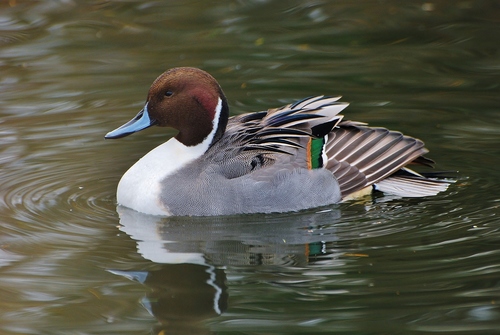
Northern Pintail
The Northern Pintail (*Anas acuta*) is a dabbling duck with a wide distribution across the Northern Hemisphere. Known for its elegant appearance and streamlined body, the male pintail is easily recognizable by its long, pointed tail feathers, which give the species its common name. This duck plays a significant role in wetland ecosystems, primarily feeding on plant material and contributing to seed dispersal. It is a highly migratory species, undertaking long journeys between breeding and wintering grounds. While not currently considered globally threatened, some populations face localized pressures.
51-66 cm
Length
79-87 cm
Wingspan
Least Concern
Conservation Status
Distribution
Breeds across northern areas of North America, Europe, and Asia. Migrates south in winter to Central America, Africa, South Asia, and parts of Southeast Asia. Altitudinal range varies, found from sea level to high-altitude wetlands in some regions.
Lifespan
The oldest recorded Northern Pintail lived over 27 years, but average lifespan in the wild is significantly shorter, likely around 3-5 years.
Northern Pintail's Habitat
Habitat Types
Shallow freshwater wetlands, Marshes, Prairie potholes, Lakes, Reservoirs, Coastal lagoons, Estuaries
Climate Zones
Arctic, Subarctic, Temperate, Tropical
Adaptations
Northern Pintails are adapted to a wide range of wetland habitats. Their long necks and specialized bill structure allow them to efficiently filter food from the water and mud. They are also strong fliers, capable of long-distance migrations.
Variations
There are no widely recognized subspecies, although slight variations in size and plumage may occur across its vast range.
Appearance
Breeding Plumage
Breeding males have a chocolate-brown head, white breast, and long, black central tail feathers. Non-breeding males resemble females. Females are mottled brown overall, providing camouflage.
Seasonal Feather Changes
Males undergo an eclipse plumage after breeding, resembling females. They regain their breeding plumage in the fall.
Sex Based Plumage Differences
Strong sexual dimorphism, with males having much more distinct and contrasting plumage during the breeding season.
Notable Features
Long, pointed tail feathers (especially in breeding males), Slender neck, Elegant, streamlined body shape, White stripe extending up the side of the neck in breeding males
Diet and Feeding
Primary Foods
Seeds of aquatic plants, Grains, Invertebrates (insects, crustaceans, mollusks), Small amounts of other plant material
Foraging Behavior
Northern Pintails are dabbling ducks, feeding by tipping their bodies forward in the water to reach submerged vegetation and invertebrates. They also graze on land, consuming seeds and grains.
Specializations
Their long necks allow them to reach deeper submerged food sources than some other dabbling ducks. Their bills have lamellae (comb-like structures) that help them filter small food items from the water.
Seasonal Diet Variations
Diet varies seasonally. During the breeding season, they consume more invertebrates, providing protein for egg-laying and chick growth. In winter, their diet shifts to primarily seeds and grains.
Behavior
Social Structure
Northern Pintails are highly gregarious, especially outside of the breeding season, forming large flocks during migration and on wintering grounds. During the breeding season, they are more dispersed, forming pairs.
Communication
Males have a distinctive whistling call., Females have a quacking call, similar to a Mallard but softer., Visual displays, such as head-bobbing and wing-flapping, are used in courtship and territorial defense.
Migration
Northern Pintails are long-distance migrants, traveling thousands of kilometers between breeding and wintering areas. They often migrate at night, navigating by the stars and Earth's magnetic field.
Territorial or Group Behaviors
Males defend territories during the breeding season, but these territories are usually small and centered around the nest site. Outside of breeding, they are highly social and form large flocks.
Conservation
Threats
Habitat loss and degradation (due to wetland drainage and agricultural expansion), Hunting pressure (in some regions), Lead poisoning (from ingestion of spent lead shot), Climate change (affecting breeding and wintering habitats), Pollution (contaminants in wetlands)
Protection Programs
North American Waterfowl Management Plan, Wetlands conservation initiatives (e.g., Ramsar Convention), Hunting regulations (in many countries)
Local National Laws
Protected under the Migratory Bird Treaty Act in the United States and Canada, and similar legislation in other countries.
Population Trend
Stable
Population Estimates
The global population is estimated to be around 2.8 - 2.9 million individuals.
Interesting Facts
They are among the earliest nesting ducks in North America.
This allows them to take advantage of early spring resources.
Northern Pintails are known for their fast and agile flight.
They can reach speeds of up to 80 km/h (50 mph).
The name "pintail" refers to the male's long, pointed tail feathers.
These feathers can make up a significant portion of the bird's total length.
Faqs about Northern Pintail
What is the difference between a male and female Northern Pintail?
Male Northern Pintails in breeding plumage have a brown head, white breast, and long, black tail feathers. Females are mottled brown overall. Males in non-breeding plumage resemble females.
Where do Northern Pintails migrate?
They migrate from breeding grounds in northern North America, Europe, and Asia to wintering areas in Central America, Africa, South Asia, and parts of Southeast Asia.
Are Northern Pintails endangered?
No, the Northern Pintail is classified as Least Concern by the IUCN. However, some populations face threats from habitat loss and other factors.
What do Northern Pintails eat?
They primarily eat seeds of aquatic plants, grains, and invertebrates, such as insects and crustaceans. Their diet varies seasonally.
Copyright @ Nature Style Limited. All Rights Reserved.
 English
English